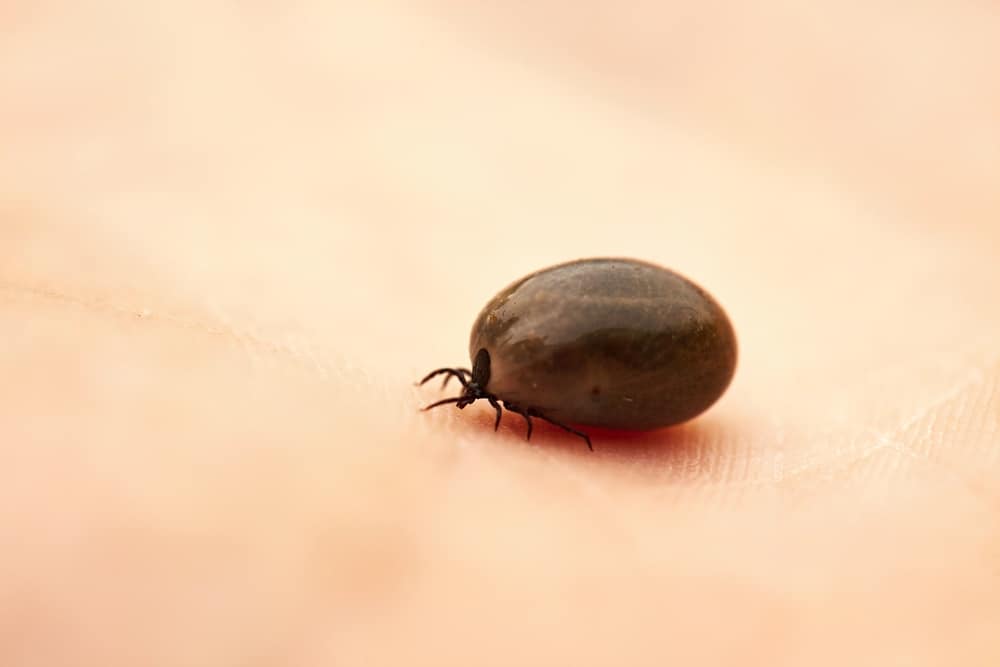
It’s that time of year again. When the weather warms up the ticks come out. The ticks we are mostly concerned about are deer ticks. Deer ticks (Ixodes scapularis) carry Lyme disease. Lyme disease in the USA is caused by a bacterial parasite called Borrelia burgdorferi.
The life cycle of this parasite is interesting in that it is picked up by deer ticks in their larval stage from small rodents. The larva then goes on to spread it to other rodents. When the larva develops into the adult tick, it then begins to attach to larger mammals to feed and transmit the parasite. In humans, it causes a disease known as Lyme disease.
Deer ticks, which are also called Black Legged ticks, are much smaller than common dog (wood) ticks. Although wood ticks can carry and transmit other diseases, they are not a vector for Lyme disease.
Even though deer ticks are known to carry B Burgdorferi, not all ticks are infected. Approximately 20% or so carry the disease, but this varies somewhat by region of the country. Furthermore, a minimum of 24 hours are required for transmission of the parasite to the human host after a tick attaches. More commonly, it takes 36 hours or more for transmission of the parasite.
Lyme disease symptoms start after 3 days, but not more than 30 days. Initially, it may start with fever, myalgias, fatigue, headaches, achy joints, and swollen lymph nodes. About 80% of patients will also get a migrating expanding rash known as Erythema Migrans. This is a unique rash that may resemble a bullseye.
It starts with redness at the area of the bite and then expands, leaving a clear center, hence the bullseye description. This type of expanding rash can later appear on other areas of the body as well.
If not recognized and treated in the first stage, it goes on to cause further and more severe symptoms over time. These symptoms can develop within days to months after the initial stage, including swollen painful joints, severe headaches, nerve problems like shooting pains in limbs or numbness or Bell’s Palsy (unilateral facial paralysis), memory problems, heart problems (carditis).
Unfortunately, many of these symptoms can be caused by other diseases also, which can result in a delayed diagnosis. It is important that patients with any of these symptoms be tested for Lyme disease by a blood test.
So what to do if you find a tick imbedded on your body? First, don’t panic. Most deer tick bites don’t result in Lyme disease. Use a tick remover: a small inexpensive curved piece of metal with a slit that is placed under the body of the tick, then gently pull off the tick. These are available in recreation equipment stores and some drug stores. You should have one available just in case.
You do not want to squeeze the tick or try to kill it with a hot match. That will just cause it to regurgitate into your body, making transmission of infection more likely. Also note that if the head remains imbedded in the skin, this is nothing to be concerned about; as the skin sheds over time the remains will fall out.
Watch for a rash or flu like symptoms especially if the tick has been present for 24 hours or more. If you develop any of the symptoms noted before, see your physician.
The life cycle of this parasite is interesting in that it is picked up by deer ticks in their larval stage from small rodents. The larva then goes on to spread it to other rodents. When the larva develops into the adult tick, it then begins to attach to larger mammals to feed and transmit the parasite. In humans, it causes a disease known as Lyme disease.
Deer ticks, which are also called Black Legged ticks, are much smaller than common dog (wood) ticks. Although wood ticks can carry and transmit other diseases, they are not a vector for Lyme disease.
Even though deer ticks are known to carry B Burgdorferi, not all ticks are infected. Approximately 20% or so carry the disease, but this varies somewhat by region of the country. Furthermore, a minimum of 24 hours are required for transmission of the parasite to the human host after a tick attaches. More commonly, it takes 36 hours or more for transmission of the parasite.
Lyme disease symptoms start after 3 days, but not more than 30 days. Initially, it may start with fever, myalgias, fatigue, headaches, achy joints, and swollen lymph nodes. About 80% of patients will also get a migrating expanding rash known as Erythema Migrans. This is a unique rash that may resemble a bullseye.
It starts with redness at the area of the bite and then expands, leaving a clear center, hence the bullseye description. This type of expanding rash can later appear on other areas of the body as well.
If not recognized and treated in the first stage, it goes on to cause further and more severe symptoms over time. These symptoms can develop within days to months after the initial stage, including swollen painful joints, severe headaches, nerve problems like shooting pains in limbs or numbness or Bell’s Palsy (unilateral facial paralysis), memory problems, heart problems (carditis).
Unfortunately, many of these symptoms can be caused by other diseases also, which can result in a delayed diagnosis. It is important that patients with any of these symptoms be tested for Lyme disease by a blood test.
So what to do if you find a tick imbedded on your body? First, don’t panic. Most deer tick bites don’t result in Lyme disease. Use a tick remover: a small inexpensive curved piece of metal with a slit that is placed under the body of the tick, then gently pull off the tick. These are available in recreation equipment stores and some drug stores. You should have one available just in case.
You do not want to squeeze the tick or try to kill it with a hot match. That will just cause it to regurgitate into your body, making transmission of infection more likely. Also note that if the head remains imbedded in the skin, this is nothing to be concerned about; as the skin sheds over time the remains will fall out.
Watch for a rash or flu like symptoms especially if the tick has been present for 24 hours or more. If you develop any of the symptoms noted before, see your physician.


